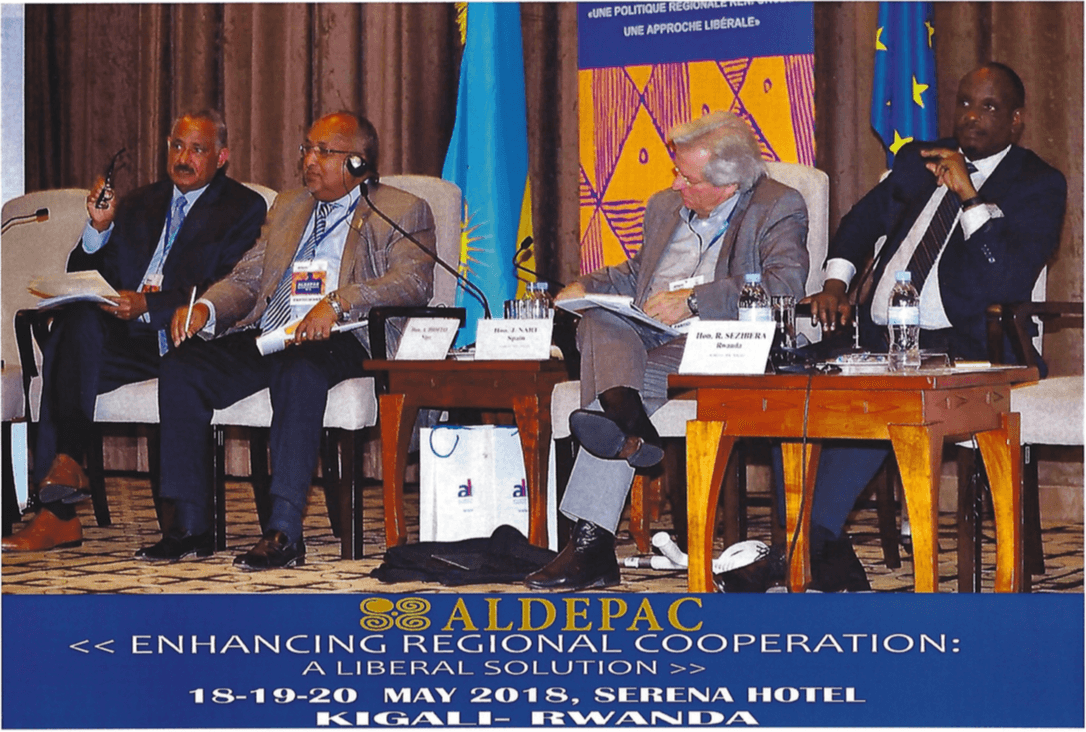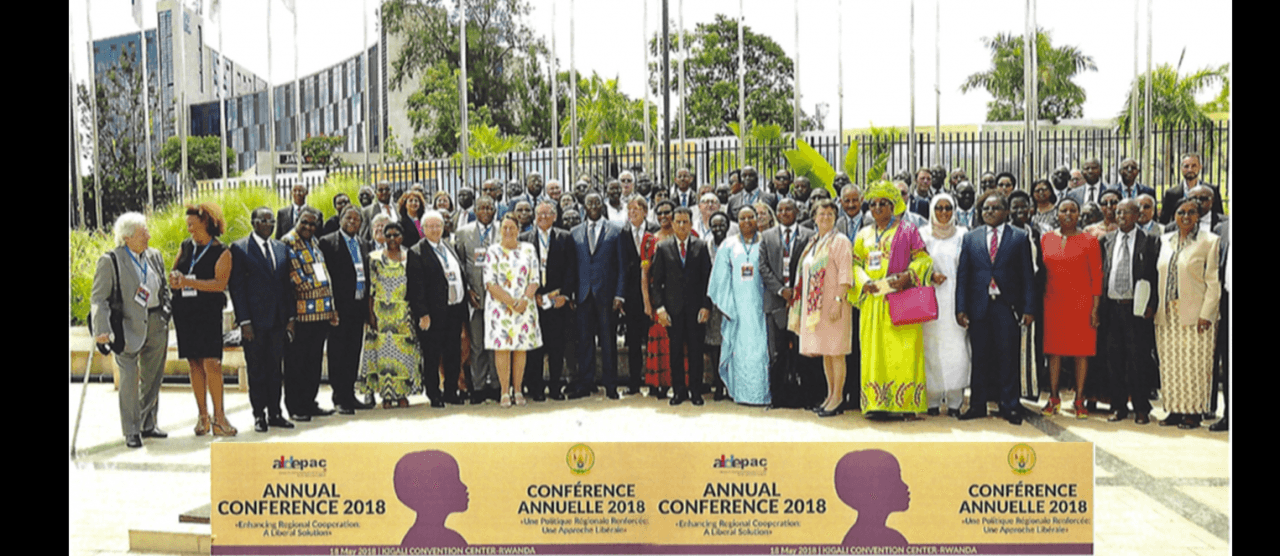On 18 May 2018, Ambassador Andebrhan Welde Giorgis delivered a speech on a new strategic approach to security in Africa at the ALDEPAC Annual Conference held in collaboration with the Rwandese Parliament in Kigali, Rwanda.
Towards a New Strategic Approach to Security in Africa
Thank you, Mr. Chairman,
Honourable Ministers, Members of Parliament, Ambassadors and Delegates,
Let me begin by expressing my deep appreciation to our hosts, the Government, the Parliament and the people of Rwanda, for their warm welcome and generous hospitality. I would also like to thank my good friend the Hon. Johan Van Hecke and the Alliance of Liberals and Democrats for Europe, Pacific, Africa and Caribbean (ALDEPAC) for organising this 13th Annual Conference of ALDEPAC here in beautiful Kigali. It is quite remarkable that Kigali has, over the last twenty-four years, risen from the ashes of war and the tragedy of genocide to become a radiant jewel in Africa. Let me also express how proud I am to have been the co-founder of ALDEPAC.
In speaking about A New Strategic Approach to Security, I wish to underscore that security has multiple dimensions. We can speak of political security, social security, military security, climate security, food security, human security, etc. Obviously, all these dimensions of security are interconnected. I will, however, focus on the need to address the political and military aspects of security in Africa as well as the internal causes and regional dynamics of the prevailing conflicts and conflict systems in the continent. I would like to share with you that my presentation draws from and complements a previously published Article.[1]
Today, militarised intrastate conflicts and jihadist terrorism continue to wreak havoc or pose serious security challenges in several parts of Africa: Burundi, the Central African Republic (CAR), the Democratic Republic of Congo (DRC), Libya, Mali, Niger, Nigeria, Somalia, South Sudan, Sudan, the Maghreb and the Sahel regions, etc. Historically, wars have hampered Africa’s economic development, social progress and human welfare and produced several failed, failing or fragile states. We all know that wars and violent conflicts cost lives, destroy property and cause human suffering. They take resources, focus and effort away from development.
Afflicted by the scourge of active or simmering conflicts of varying intensity and their spillover effects, Africa stands out as the most war-torn, conflict-ravaged and crisis-ridden continent. Most of the current conflicts are intrastate, unfolding within the confines of given national boundaries, while certain interstate conflicts have become integral parts of regional conflict systems, with each specific conflict situation having its own autonomous internal dynamics and a regional dimension.
The cumulative impact of this reality has been a state of general underdevelopment, impoverishment and miserable human condition in the affected countries of Africa. In a very real sense, wars and violent conflicts have contributed to Africa’s overall economic, political and strategic marginalisation in world affairs.
Africa’s postcolonial history clearly demonstrates the existence of a strong link between security and development; that peace, security and stability are indivisible. They are also essential conditions for: (1) economic growth, social progress and cultural advancement; (2) democratic, sustainable and inclusive development; and (3) rule of law, democratic development and respect for human rights. The regional, cross-border and spillover effects of violent conflicts and resultant insecurity thus require a regional approach.
As part of the drive towards the economic integration and political union of the continent, the African Union (AU) has created a continental security apparatus. The establishment of the African Peace and Security Architecture (APSA) [2] aims to: (1) Promote peace, security and stability as a foundation for the democratic, sustainable and inclusive development of the continent; (2) Serve as a vehicle for conflict prevention, management and resolution; (3) Foster democratic principles and institutions, good governance and human rights; (4) Enable the African Union to apply the principle of ‘non-indifference’ to situations of grave mass atrocity and work out ‘African solutions to African problems’. There should, however, be a caveat: the principle must not be used as an excuse or a cover for inaction where action is required.
It might be useful here to take a close look at the AU’s security apparatus in terms of its formation, organizational setup and mode of operation and assess its possibilities and challenges. APSA and all aspects of peace and security policy fall under the general auspices of the AU Peace and Security Council (PSC) and the Chairperson of the AU Commission. It has three key operational components: the African Standby Force (ASF), the Continental Early Warning System (CEWS) and the Panel of the Wise (POW). The Panel of the Wise operates at the AU level, while the African Standby Force and the Continental Early Warning System are attached to five of Africa’s eight regional economic communities (RECs).[3] A Military Staff Committee, made up of representatives of the fifteen AU Peace and Security Council member states, provides military and security advice to the PSC.
The African Standby Force is made up of five brigades, each linked to one of the five RECs. The five brigades are (1) EASBRIG, the East African Brigade; (2) SADCBRIG, the Southern African Brigade; (3) ECOBRIG or WESBRIG, the West African Brigade; (4) CENBRIG, the Central African Brigade; and (5) the North African Brigade). The brigades comprise multidimensional contingents with civilian, military and police components located in the countries of origin. At present, the five regional brigades are at varying degrees of formation and development. When fully formed and operational, the regional brigades will avail the AU of a total of 15,000 to 20,000 troops. A special Peace Fund, financed from the AU’s regular budget and voluntary member state contributions, has been set up to fund peace support operations.
The operationalisation of the African Standby Force has been postponed several times. When it becomes fully operational, the ASF is intended to serve as a Rapid Reaction Force capable of deployment at short notice on missions of conflict prevention, peacekeeping, peacebuilding and humanitarian assistance anywhere on the continent. It would be deployed under AU mandate and placed under AU/UN operational control, as applicable.
The Continental Early Warning System, based in the situation room at AU headquarters in Addis Ababa, Ethiopia, is designed to anticipate and prevent conflicts. Its reports, compiled from open sources and information fed from the regional early warning systems, aim to identify and flag potential crisis flashpoints and dangers, help inform the decisions of the Peace and Security Council and guide the deployment of the African Standby Force.
The Panel of the Wise is made up of five eminent persons representing the five regions of Africa. The current members are Mrs. Ellen Johnson Sirleaf (Liberia) for Western Africa; Dr. Speciosa W. Kazibwe (Uganda) for Eastern Africa; Mr. Armah Moussa (Egypt) for Northern Africa; Mrs. Catherine Samba-Panza (Central African Republic) for Central Africa; and Mr. Hifikepunye Pohhamba (Namibia) for Southern Africa. The Panel of the Wise is designed to work as an advisory and mediation body in conflict prevention. It provides support and advice to the Peace and Security Council, either on its own initiative or on demand from the PSC and/or the Chairperson of the AU Commission, on issues of peace and security. It also mediates between warring and opposing groups or discretely raises politically sensitive issues with the Peace and Security Council.
Although the establishment of the African Peace and Security Architecture shows the AU’s desire to prevent, manage and resolve conflicts in Africa, its record to date is quite mixed. AU intervention in several flashpoints, such as Burundi, Somalia, Sudan, South Sudan, etc., might have contributed to averting further escalation of violence and served as a bridge for subsequent deployment of UN missions. So far, however, APSA remains work in progress and faces several key challenges, compounded by festering interstate conflicts and rivalries within and among regions. Let us take a quick glance at some of these issues.
First and foremost is the question of viability. To be viable, APSA must be anchored in the political will of African states, supported by the African peoples and sustained mainly by African resources. Even though it appears fine on paper, its practical dependence on external funding is neither desirable nor sustainable. Self-financing from the AU budget and dedicated member state contributions would be necessary to ensure APSA’s viability, functional autonomy and independence of policy- and decision-making.
Second, there is a need for an African consensus on the basic principles and objectives. Beyond nebulous oratory and formal declarations, African states have demonstrated quite insufficient commitment. This is apparent in a general reluctance to give up national sovereignty in favour of building a robust AU mandate. The lack of real political will and readiness of African leaders to intervene, in practice, in the internal affairs of African states, to invest in the full formation and consolidation of the ASF and to operationalise its mandate is a key constraint hampering progress in the development of APSA. This is manifest in the slow progress made in the formation and integration of the five regional brigades of the ASF, the limitations of AU peace support operations experienced in Sudan and Somalia, and the reluctance of member states even to pay their statutory contributions to the AU on time. An AU sub-committee report in February 2009 indicated that 34 out of the AU’s 53-member states were in arrears of one or two years in their contributions for the 2008 financial year.
Third, the African Peace and Security Architecture faces pending structural issues. The African Standby Brigade is affiliated with five of Africa’s eight RECs. There is overlapping membership of several states in different RECs - a structure that greatly resembles the configuration of a “spaghetti bowl” - and dual affiliation in regional brigades. For instance, Madagascar and Seychelles are in both EASBRIG and SADCBRIG, while Angola and the DRC are in both SADCBRIG and the Central African Brigade. Such overlaps constitute a major drawback, operate to undermine coherence and hinder close coordination within each region as well as among the five regions in operationalising the ASF and developing APSA.
The uneven development of the five regional brigades of the ASF in terms of formation, command and control, capacity, structure and coherence poses a fourth challenge. SADCBRIG, formed in 2007 and ECOBRIG formed in 2009, are operational. EASBRIG and CENBRIG are paralysed by unresolved interstate conflicts and rivalries within IGAD and ECCAS. The North African Brigade has yet to be formed. Moreover, uneven development affects the smooth integration of the regional brigades, the operationalisation of the ASF and the implementation of the peace and security mandate of the APSA. Under these circumstances, five Sahelian states have established the G5 Sahel[4] that operates outside the APSA framework to coordinate regional cooperation in development policies and security matters. With significant international and substantial EU and Member States support, the five Sahelian states are committed to operationalise their joint forces to fight jihadist terrorist operations in the region.[5]
The interrelated issues of ownership and capacity of the African Union represent a fifth challenge. Modelled very much after the EU, the AU is still in its relative infancy, barely two decades old. As an essentially European construct transplanted in Africa, it must strive to take root in an African grounding, pursue autonomous development and gain grassroots support. Despite its ambitious goals and elaborate structures, it lacks the requisite financial resources, the necessary popular support and the critical mass of competence and technical expertise to fully build and operationalise the African Peace and Security Architecture, develop the Continental Early Warning System and establish, train, equip and deploy the African Standby Force.
The impact of these constraints is often aggravated by divergent interests and incoherent responses from Africa’s international partners, including the European Union and its Member States. I would like to mention just three examples to illustrate the debilitating and often disastrous effect of these constraints:
First, lacking the necessary manpower, logistics and materiel, the AU peacekeeping operations in Sudan (AMIS) and Somalia (AMISOM) proved unable to stop the violence and protect civilians in South Sudan, Darfur and Somalia. Prior to the deployment of the UN-AU Mission in Darfur (UNAMID), AMIS repeatedly had to watch helplessly as government troops, militias and rebels violated ceasefire agreements, killed civilians and attacked its units with impunity. Unable to stem the violence, AMIS, AMISOM and UNAMID operated like toothless bulldogs.
Second, the Inter-Governmental Authority (IGAD), with its member states working in concert and the IGAD Partners Forum (IPF) providing coherent international support, was able to broker the Comprehensive Peace Agreement (CPA) between North and South Sudan. With some member states at loggerheads with each other and key global actors pursuing divergent objectives, however, IGAD has been effectively paralysed as a regional peace and security actor. Member State conflicts and rivalry have undermined its capacity to serve as an honest broker or contribute to the implementation of agreements reached to resolve the crises in Somalia, Sudan, South Sudan, or the Eritrea-Ethiopia and Djibouti-Eritrea conflicts.
Third, despite the repeatedly prolonged deployment of the UN Mission in the Democratic Republic of Congo (MONUC), UNAMID in Darfur and UNMISS in South Sudan, violence continues to rage with mounting atrocities against civilians, including women and children, while durable peace remains elusive in the Democratic Republic of Congo, in Darfur and South Kordofan in the Sudan as well as in South Sudan.
No doubt, the mix of internal challenges and external incoherence constrains the operationalisation of APSA and hinders the implementation of its mandate. AU reform and international assistance in support of African peace and security efforts must thus, first and foremost, endeavour to tackle these key challenges. Without meaningful reform, the amount of financial assistance and quality of technical support forthcoming from Africa’s international partners, especially the EU, although of critical importance to the continent’s efforts to tackle these challenges, will not suffice. Addressing these constraints to the successful achievement of Africa’s peace and security objectives will require a new paradigm of African self-reliance and more effective coordination of international support for the continent’s home-grown agenda.
While Africa must work hard to develop its own capacity to operationalise APSA based on its own resources, it can also count on significant international support. The EU, in particular, has provided strategic partnership and cooperation to boost Africa’s peace and security efforts in the framework of its Common Foreign and Security Policy (CFSP) and the African Peace Facility (APF) financed through the European Development Fund (EDF). The Africa-EU Partnership on Peace and Security formally commits the strategic partners to work together to build the African Peace and Security Architecture and fully operationalise its mandate. Furthermore, the EU provides comprehensive support for peace and security operations in Africa, both at the continental and regional levels, embracing military, police and civilian dimensions.
Beyond the dark side of the colonial legacy, Europe and Africa have mutual strategic interests, common objectives and shared values of respect for the rule of law, democratic principles and human rights. Accordingly, the EU and the AU must work to reinforce their strategic partnership. They should, in particular, endeavour to: (1) enhance the quality of their dialogue and strengthen their cooperation at the level of policy, programmes and implementation to meet the multiple challenges to peace and security; (2) focus joint effort on prevention through the promotion of democratic governance, inclusive development, broader national consensus and improved regional cooperation, since ‘prevention is cheaper than cure’; (3) deliver more integrated rather than fragmented EU and Member State support; and (4) ensure policy coherence and political support for timely implementation of peace accords between parties in conflict, such as the Algiers Agreement between Eritrea and Ethiopia.
In conclusion, I would like to underscore that peace and security are primarily political rather than military issues. Good governance, inclusive development and respect for human rights represent a solid basis for domestic peace, security and stability. At the same time, universal civic education, combined with sustainable and inclusive development, would provide for an equitable sharing of the fruits of economic growth and eliminate the ignorance and poverty that avail fertile recruiting grounds for violent and extremist movements of all hues and colours. Equally importantly, enabling vibrant and autonomous civil society organisations would help build social consensus and countervail violations of democratic principles, rule of law and human rights by governments. I hope that the proposed reform of the African Union would address the prevailing shortcomings to enable Africa to manage and resolve its political crises.
Thank you for your kind attention.
[1]Andebrhan Welde Giorgis, Coordinating International Support for African Peace and Security Efforts: From the G8 to the EU, The International Spectator, Vol. 45, No. 2, June 2010.
[2] Establishment of the Peace and Security Council, http://www.africa-union.org/root/au/AUC/Departments/PSC/Asf/doc/PSC%20protocol.pdf
[3] The eight African regional economic communities are: (1) Arab Maghreb Union (AMU), (2) the Economic Community of West African States (ECOWAS), (3) the East African Community (EAC), (4) the Inter-Governmental Authority on Development (IGAD), (5) the Southern African Economic Community (SADC) (6) the Common Market for Eastern and Southern Africa (COMESA), (7) the Economic Community of Central African States (ECCAS), and (8) the Community of Sahel-Saharan States.
[4] The G5 Sahel comprise Burkina Faso, Chad, Mali, Mauritania, and Niger.
[5] Terrorist organisations operating in the region include: Al-Qaeda
in the Islamic Maghreb (AQIM), Movement for Unity and Jihad in West Africa
(MUJWA), Al-Mourabitoun, and Boko Haram.



